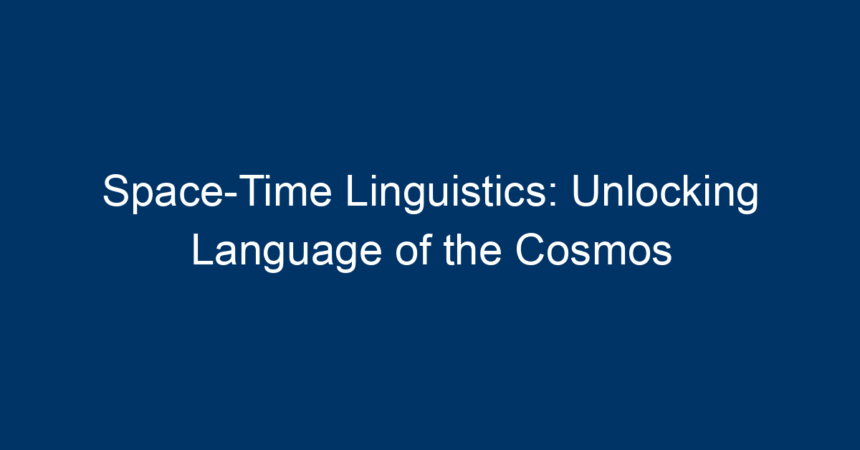The universe is vast and mysterious, with intricacies that often lie beyond human comprehension. However, as humanity continues to expand its understanding of physics, astronomy, and linguistics, a fascinating intersection emerges—space-time linguistics. This evolving field seeks to uncover how language interacts with our understanding of space and time, and how it influences our perception of the cosmos. In this article, we delve deep into the principles of space-time linguistics, its implications for understanding the universe, and the potential it has for revolutionizing communication, science, and our grasp of reality.
What is Space-Time Linguistics?
Understanding the Basics
At its core, space-time linguistics intertwines elements of linguistics with the concepts of space and time derived from physics. Traditional linguistics focuses on the structure, meaning, and context of languages. However, by integrating these elements with theories of relativity and quantum physics, space-time linguistics aims to explore how language shapes and is shaped by our understanding of the cosmos.
Theoretical Foundations
Space-time linguistics is deeply rooted in two foundational theories:
-
Relativity: This theory, proposed by Albert Einstein, revolutionized our understanding of space and time, suggesting they are interwoven into a single continuum. Time can vary for different observers based on their relative motion, which raises intriguing questions about how languages represent these concepts.
- Cognitive Linguistics: This branch of linguistics examines how language reflects and shapes our cognitive processes. Exploring how humans perceive space and time can provide insights into how different languages encode these abstract concepts.
The Intersection of Language and Perception
Linguistic Relativity and Spatial Awareness
One of the main tenets of space-time linguistics is linguistic relativity, commonly known as the Sapir-Whorf hypothesis. This hypothesis posits that the language we speak influences our thoughts and perceptions. In terms of space-time linguistics:
-
Spatial Attention: Different languages utilize various spatial orientations. For example, some languages rely heavily on cardinal directions (north, south, east, west) rather than egocentric references (left, right). This suggests that speakers of these languages develop a heightened spatial awareness, affecting their understanding of space.
- Temporal Constructs: Similarly, the way people express time can shape their perception of it. In English, we frequently use time metaphors related to motion (e.g., "the deadline is approaching"). This reflects our conceptualization of time as linear, influencing how we plan and perceive events.
Translation of Spatial and Temporal Concepts
In practical terms, space-time linguistics can significantly impact translation practices. Understanding how different cultures construct their understanding of time and space allows translators to convey meaning accurately. For example, when translating a text from a language that uses a cyclical view of time into a linear language, it becomes essential to capture the cultural nuance embedded in those temporal structures.
Applications of Space-Time Linguistics
Enhancing Scientific Communication
In scientific fields, where precise language is critical, understanding space-time linguistics can enhance clarity. For instance:
-
Astronomy: As scientists grapple with the complexities of black holes or the expansion of the universe, communicating these concepts requires a nuanced understanding of how language can effectively represent these phenomena.
- Physics: Researchers often encounter difficulties explaining relativistic principles to the general public. An awareness of space-time linguistics can empower educators to articulate these concepts through relatable language and metaphors.
Informing Artificial Intelligence
As artificial intelligence systems continue to evolve, infusing space-time linguistics into natural language processing can enhance the AI’s understanding of human context.
-
Contextual Awareness: AI systems that grasp the intricacies of space and time as defined by various cultures will be better equipped to interpret user intent and context.
- Data Interpretation: By interpreting data through a space-time linguistics lens, AI can provide more meaningful insights into contextual trends, especially in fields like social sciences and market research.
Case Studies in Space-Time Linguistics
Indigenous Languages and Cosmology
Indigenous languages often reflect deep connections between language, culture, and a holistic understanding of the universe. For example:
-
The Aboriginal Yolŋu Matha: This language emphasizes a landscape-oriented perspective, where spatial relationships govern temporal understanding. This approach offers insights into how the Yolŋu perceive their environment in relation to cosmic phenomena, leading to a rich tapestry of storytelling that interweaves space, time, and identity.
- Navajo Language: The Navajo language incorporates complex verb forms that indicate time while simultaneously encoding spatial information, revealing how through language, the Navajo culture remains intimately linked to both their physical surroundings and their conception of time.
Modern Scientific Theories
Recently, scientific narratives are increasingly relying on space-time linguistics to articulate theories. Quantum entanglement, for example, challenges traditional notions of locality in space and time. Framing these concepts in linguistic terms is crucial to making them accessible to broader audiences and promoting further research.
Future Directions in Space-Time Linguistics
Bridging Disciplines
As the future of space-time linguistics unfolds, a trend toward interdisciplinary collaboration is emerging. Linguists, physicists, cognitive scientists, and educators are collaborating to enhance understanding:
-
Cognitive Science: Advanced studies into how the brain processes spatial and temporal information will contribute to linguistics and further define the intersection of these fields.
- Virtual Reality: With the rise of virtual reality, researchers can explore how immersive environments influence linguistic perceptions of space and time.
Educational Frameworks
In educational settings, integrating space-time linguistics can enhance the teaching of languages, sciences, and integrated learning.
-
Curriculum Development: Educators can develop curricula that emphasize the relationship between language and perception, fostering critical thinking about language, culture, and our understanding of the cosmos.
- Workshops and Seminars: Institutions can host workshops that bring together linguists and scientists to discuss the implications of space-time linguistics. These collaborative efforts can push the boundaries of how we understand human cognition and communication.
Conclusion: Unlocking Cosmic Communication
Space-time linguistics presents a thrilling frontier in the study of language and the universe. By exploring how language shapes our perception of space and time, we can unlock new methodologies for communication, enhance scientific understanding, and foster deeper connections across cultures.
As we continue to navigate the intricate tapestry of our universe, recognizing the role of language in shaping our cosmic narratives becomes paramount. For educators, researchers, and communicators, embracing the insights of space-time linguistics may very well illuminate pathways to understanding not only our world but the cosmos beyond.
Actionable Insights
-
Explore Linguistic Diversity: Examine how different cultures express spatial and temporal concepts to enrich your understanding of communication styles.
-
Engage with Science: Stay informed about how space-time linguistics is being applied in scientific fields and consider how this knowledge can impact your work or studies.
- Collaborate Across Disciplines: Seek opportunities for collaboration that blend linguistics, science, and technology, focusing on innovative approaches to problem-solving and communication.
In this rapidly evolving landscape, space-time linguistics stands as a testament to the power of language in shaping our understanding of the universe. As we unlock its mysteries, we may find new ways to articulate the unknown, bringing the cosmos closer to our everyday understanding.




